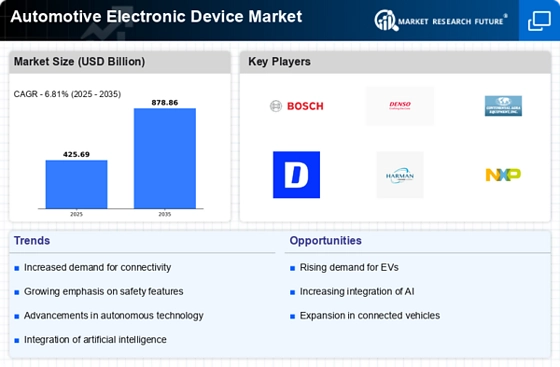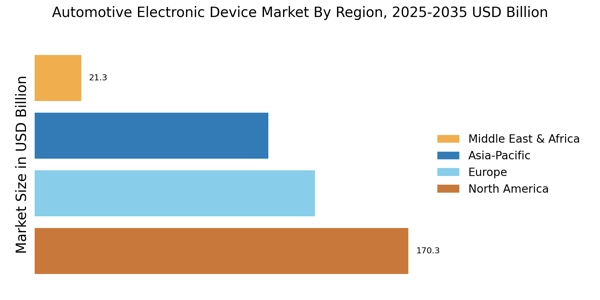Advancements in Infotainment Systems
The Automotive Electronic Device Market is witnessing significant advancements in infotainment systems, which are becoming increasingly sophisticated. Modern vehicles are now equipped with integrated multimedia systems that offer navigation, entertainment, and connectivity features. The market for automotive infotainment systems is expected to grow at a compound annual growth rate of 10% over the next five years. This growth is attributed to consumer preferences for seamless connectivity with smartphones and other devices. As automakers strive to enhance the driving experience, the Automotive Electronic Device Market is likely to see a rise in demand for high-definition displays, voice recognition, and advanced user interfaces.
Growing Demand for Enhanced Safety Features
The Automotive Electronic Device Market is experiencing a notable surge in demand for enhanced safety features. Consumers increasingly prioritize safety in their vehicle purchases, leading manufacturers to integrate advanced electronic systems. According to recent data, the market for automotive safety electronics is projected to reach USD 30 billion by 2026. This growth is driven by the implementation of technologies such as automatic emergency braking, lane departure warning systems, and adaptive cruise control. As regulatory bodies impose stricter safety standards, the Automotive Electronic Device Market is likely to expand further, with manufacturers investing heavily in research and development to innovate and comply with these regulations.
Increased Focus on Environmental Sustainability
The Automotive Electronic Device Market is increasingly influenced by a focus on environmental sustainability. As consumers become more environmentally conscious, there is a growing demand for electric and hybrid vehicles, which rely heavily on advanced electronic systems. The market for automotive electronics in electric vehicles is projected to grow significantly, with estimates suggesting it could reach USD 25 billion by 2025. This shift towards sustainable transportation solutions is prompting manufacturers to innovate and develop energy-efficient electronic devices. Consequently, the Automotive Electronic Device Market is likely to evolve, with a greater emphasis on reducing carbon footprints and enhancing energy efficiency.
Rising Consumer Expectations for Personalization
The Automotive Electronic Device Market is responding to rising consumer expectations for personalization in vehicles. Modern consumers seek tailored experiences, prompting manufacturers to develop customizable electronic features. This trend is reflected in the growing demand for adaptive cruise control, personalized infotainment options, and driver assistance systems that learn user preferences. Market Research Future indicates that the personalization segment within automotive electronics could grow by 15% annually over the next few years. As automakers strive to meet these expectations, the Automotive Electronic Device Market is likely to witness a shift towards more user-centric designs and functionalities.
Integration of Internet of Things (IoT) Technologies
The integration of Internet of Things (IoT) technologies is transforming the Automotive Electronic Device Market. IoT enables vehicles to communicate with each other and with infrastructure, enhancing safety and efficiency. The market for IoT in automotive applications is expected to grow substantially, with projections indicating a value of USD 50 billion by 2027. This growth is driven by the increasing adoption of connected vehicles and smart city initiatives. As automakers invest in IoT solutions, the Automotive Electronic Device Market is likely to see innovations that improve traffic management, reduce accidents, and enhance overall driving experiences.

















Leave a Comment